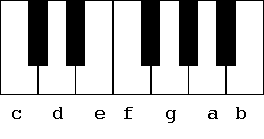Learn to improvise. 2003-2004. Lesson 01: musical tones, chords C, G and G7.
Minimum requirements for this course:
- A musical instrument to play on, preferably a piano, keyboard, organ or accordion, because
these instruments can illustrate how harmony goes together with melody.
- A computer that can play the sounds MIDI and WAV.
- A connection with the Internet. Cable is not necessary, as every lesson and every sound
example can be saved and offline be used.
The name of the keys:
 This is one octave.
This is one octave.
The piano has about 7 of them.
The white keys are called:
c, d, e, f, g, a, b.
The black keys get their names from their neighbors.
So each of them can be named in two ways:
- by raising: c#, d#, f#, g#, a# (pronounce: c-sharp, d-sharp, etc.)
- by lowering: db, eb, gb, ab,
bb (pronounce: d-flat, e-flat, etc.)
When do you raise en when lower?
This depends on the note you like to leave out.
E.g. if you play the notes c d e f g a b c, you play the scale of C.
Now, if you want to hear the same melody but starting at g,
you will have to play the notes:
g a b c d e f# g. This is the scale of G.
In this case you will call the black key f# in stead of gb,
because the black key has replaced the note f.
The note f is left out in the scale of G.
(Of course the note g is hard to leave out in de scale of G.)
If it is necessary to indicate notes in a particular octave one adds a cipher to it, starting at the lowest octave with 1. So: c1, d1, e1, etc. are low bass notes; c2, d2, etc. are higher; until c7, d7, etc, which are very high.
The note c4 is the middle c.
For didactical reasons I will only use one way of notation for every notion.
E.g. in stead of do-re-mi, etc, I will indicate notes always as c-d-e, etc.
Furthermore I will never use capitals for notes and always use
capitals for other things, like a chord, scale or tonality.
As I don't use note symbols, I mean by the word 'note' always the musical tone.
A chord is a group of three or more notes sounded at the same time.
The name of a chord is independent of double notes,
so if a chord has among others g4 and g5, these two count just for g.
So a chord can be made in many ways, called positions.
I will give the position of a chord by writing the notes from left
to right and around the middle c. In this way I don't have to draw a
figure every time. E.g.:
 This is a chord G.
This is a chord G.
I will indicate this as: g-b-d-g.
The note c between these notes is the middle c.
 This is a chord C.
This is a chord C.
I will indicate this as: g-c-e.
Together with C usually G7 (g-b-d-f) is used.
In these positions the chords C and G7 can easily be changed from one to the other.
HOMEWORK: Play the chords C and G7 in the indicated position.
Learn them for the left hand as well as for the right hand.
Pay attention to your fingering in order to have the hands relaxed
and to be able to switch between the two chords easily (blind).
Try to make music with them, by humming with your voice.
Make it nice. Touch the keys lightly. Sell your music to yourself. Enjoy it.
Don't think: "This is nothing". For centuries people have longed for the music you make.
Click here to hear the chords (example of 2 minutes in MIDI). As variation you can play them as broken chords (not all tones simultaniously).
<< Homepage / Index of the course / Next page >
 This is one octave.
This is one octave.![]() This is a chord G.
This is a chord G.![]() This is a chord C.
This is a chord C.